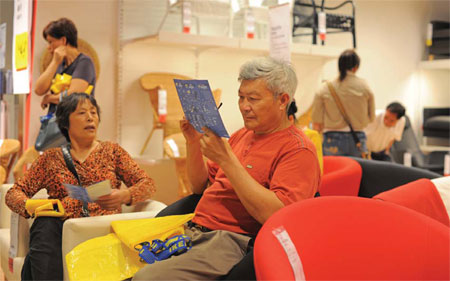Starting at the top
Updated: 2012-08-17 08:45
By Wang Chao (China Daily)
|
||||||||
Jeff Gong, director of Beijing Vogue Glamour Brand Marketing Inc, a brand consultancy, says many foreign brands have taken advantage of this mindset among Chinese consumers. Gong's agency has helped introduce many European brands, especially clothing majors, to set up shop in China.
"There are several stages in consumer behavior like following, self-experiencing and cultural identity," Gong says. "Due to the lack of information on luxury goods and the relatively late development of the consumer market, Chinese customers are still in the 'following' stage," he says.
Gong says that the best example of the blind trend can be found in the Chinese obsession for luxury products sporting big logos. "Most of the affluent people tend to buy what looks good and expensive, especially in the case of imported products."
|
Customers at a store of popular Swedish home furnishing company Ikea. Provided to China Daily |
|
Left: Lex Keijser, general manager of H&M Greater China and Singapore Region. Right: Dale Preston, managing director of retail measurement at Nielsen Greater China. Photos Provided to China Daily |
While positioning for higher sales numbers is the most common strategy adopted by companies, in some instances the higher re-branding is necessary for companies to make up for the higher market entry costs.
"I don't think they do it intentionally, but the Chinese market is the most fragmented in the world. With such a big size and population, marketing in China is like marketing in the whole of Europe, and one has to take into account the different preferences across different regions."
In addition, running a national advertisement campaign can also be prohibitively expensive, he says.
Preston says it is possible for most of the foreign brands to go in for the higher positioning, as there are still a lot of misconceptions among Chinese consumers.
"It is also more of a cultural thing. In India and Brazil, customers don't buy the product to show off their wealth. But in China, using expensive products is considered a status symbol.
"There are lots of opportunities for foreign companies to further upgrade their image in China. With more than 500 million Chinese people still living in villages, it will take decades for many of them to urbanize and accept the new concepts."
But that does not mean that the road ahead is a smooth one. There are potholes ahead, Preston says, adding that "competition will be fierce as more second-tier brands are now moving to China".
Foreign card
While the higher positioning has been advantageous for brands like Days Inn, in the case of many others like the Swedish furniture maker Ikea, it has more been a case of passive re-branding. Yvonne Yin, public relations manager of Ikea Retail China, says that the company adopts the same kind of positioning everywhere in the world and its products are targeted at mass consumers.
But in China, the company is still considered a novelty by most of the consumers.
Such has been the draw of the brand that it is not uncommon to see people speaking various dialects thronging the company stores in China. Most of the visitors to the store are women aged between 20 and 50, including a large portion of white-collar workers.
In the traditional Chinese home decoration concept, tidiness and order are highly appreciated - walls are often snow white and furniture is placed along the wall. But in the Ikea outlets, Chinese customers can often be found making a beeline for the living room couches, book shelves that can be nailed onto the wall, and flowers hanging from the window.
"Most customers treat Ikea as a symbol of Western way of life," Yin says. "That's why we are considered a 'petit bourgeoisie' brand, maybe because of our display, but not because of our intention to do so."

 Relief reaches isolated village
Relief reaches isolated village
 Rainfall poses new threats to quake-hit region
Rainfall poses new threats to quake-hit region
 Funerals begin for Boston bombing victims
Funerals begin for Boston bombing victims
 Quake takeaway from China's Air Force
Quake takeaway from China's Air Force
 Obama celebrates young inventors at science fair
Obama celebrates young inventors at science fair
 Earth Day marked around the world
Earth Day marked around the world
 Volunteer team helping students find sense of normalcy
Volunteer team helping students find sense of normalcy
 Ethnic groups quick to join rescue efforts
Ethnic groups quick to join rescue efforts
Most Viewed
Editor's Picks

|

|

|

|

|

|
Today's Top News
Chinese fleet drives out Japan's boats from Diaoyu
Health new priority for quake zone
Inspired by Guan, more Chinese pick up golf
Russia criticizes US reports on human rights
China, ROK criticize visits to shrine
Sino-US shared interests emphasized
China 'aims to share its dream with world'
Chinese president appoints 5 new ambassadors
US Weekly

|

|









